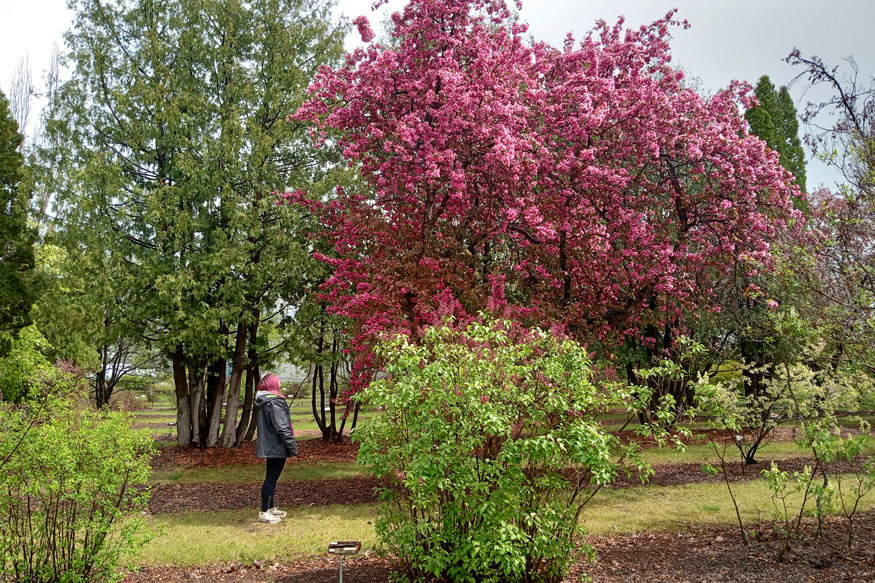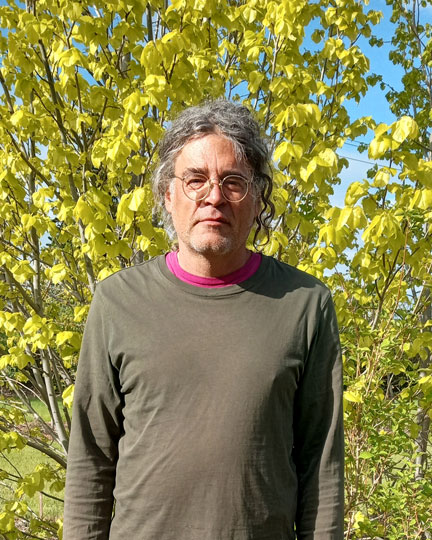
Ask the Alumni Expert: Alan Weninger (BSc’87)
USask graduate Alan Weninger, arborist for Patterson Gardens, talks about his favourite trees and shares his planting tips for the spring season.
By SHANNON BOKLASCHUKSince 2006, University of Saskatchewan (USask) graduate Alan Weninger (BSc’87) has worked as a gardener and arborist for the College of Agriculture and Bioresource’s Department of Plant Sciences. His focus is on USask’s Horticulture Facility and the Patterson Garden Arboretum, which was established in 1966 as part of the Prairie Regional Trials for Woody Ornamentals experiment.
Weninger is an ISA Certified Arborist who earned his Bachelor of Science degree in microbiology from USask’s College of Arts and Science in 1987 and his Horticulture Certificate from the University of Guelph. He is passionate about botany and the cultivation of woody plants and has grown trees as a hobby for many years, maintaining a diverse collection near Saskatoon.
With spring planting now on the minds of many aspiring arborists, the Green&Whiteasked Weninger about his favourite trees and his planting tips.

You serve as the arborist for Patterson Gardens at USask. What is the Patterson Garden Arboretum?
Patterson Arboretum is a living collection of woody plants growing outdoors at the University of Saskatchewan. The collection contains most of the trees, shrubs, and vines that are native to northern regions of North America, Europe, and Asia. Some of these are very rare in cultivation here, and many are significant for conservation or as part of our local horticultural heritage. Many of the specimens are labelled. The arboretum is open to the public, and we also provide tours to groups when requested. My job there, as part of the Horticulture Field Facility, is to care for the trees, to plant new seedlings for trial, and to keep records. It’s a great place to work.
What are some of the unique trees, shrubs, and woody vines that visitors will see there?
There are literally hundreds of woody plants there that visitors have probably never seen or thought about before and, contrary to what might be expected, these haven’t all come from far-off lands. For instance, we have narrowleaf cottonwood, skunkbush, and silver sagebrush, which are native to areas of southern Saskatchewan and Alberta; a western larch, which is native to the Rocky Mountains in B.C. and Alberta yet never seen in cultivation (I collected the seed to grow it while on a ski trip in B.C.); and Manitoba natives, including smooth sumac, sweetfern, leadplant, sweetgale, basswood, Canadian moonseed vine, and American hop-hornbeam. A few of the more exotic trees that I usually point out in tours include Kentucky coffee tree (Gymnocladus dioica), Chinese catalpa (Catalpa ovata), Japanese emperor oak (Quercus dentata), Manchurian walnut (Juglans mandshurica), and Manchurian black hawthorn (Crataegus chlorosarca).
The Patterson Garden Arboretum is located in zone 3b of the plant hardiness zones of Canada. What does this mean, and what woody plants will thrive there?
The plant hardiness rating gives gardeners a rough idea if a particular plant will survive their expected winter low temperatures. In Saskatoon this is about – 40 C, although survival depends on many factors. For instance, on the east side of our Horticulture Field building, which protects plants from the west wind, we can grow young trees of cucumbertree magnolia (Magnolia acuminata), shagbark hickory, and American sycamore, all of which have all not been able to survive in Patterson Arboretum so far. Of course, any tree that is native to the Prairie provinces will always be able to survive our winter cold, as will plants native to northern Eurasia.
You have also grown trees as a hobby for many years and you have a diverse collection near Saskatoon. What interests you about trees?
I’m interested in all plants, but I focus on the ones that are easy for me to keep, like trees and shrubs. My farm trees are growing in a semi-wild state; I plant them as seedlings and then keep the weeds down around them to hasten their growth. The older ones I can walk through and study their flowers, fruit, leaves, and bark. Every year, as they mature, I will see something that I’ve never seen before in this regard. I can study world tree botany any time in my collection.
What is your favourite tree?
I especially like oaks and pines. They both have a lot of expression in their trunks and their shape, and this gets better the older they get. Both groups will grow well in dryish soil, so they always seem contented and healthy here. I especially like ponderosa pines, with their long needles, which become very dense towards the top of the tree. Sometimes I look at them in disbelief, that they could make so much beauty from a piece of dry ground.

Ohio buckeyes are small trees that have a lot going for them. The buds open quickly into large leaf plumes in early spring, followed by creamy yellow flower panicles at the branch tips. The large spiky fruit capsules, with smooth, large, chestnut-coloured seeds inside, are also interesting. They also have thick twigs, unusual palmate leaves, and somewhat spongy bark.
The shrub Sibiraea laevigata is a favourite of mine. It has distinctive spatulate-shaped leaves, which are a pale green colour. It also leafs out early and blooms at this time of year, late May, from the branch tips, with large white clusters of tiny flowers. It is related to Spiraea, but much more interesting in my opinion. It looks exuberant when planted in a sunny spot. Its alternate name is Sibiraea altaiensis, named after the Altai Mountains in Russia and Mongolia, and was part of my inspiration to go on a botany trip there. As luck would have it, I didn’t see any in the wild, but it was present in a local botanical garden.
What is the best time of the year to plant trees in Saskatoon and area?
Spring is always the best time, before the leaves are fully out. All trees and shrubs seem more tolerant of the root disturbance then, since the weather is cool and so there is less chance of the leaves drying out.
What planting and tree care tips do you have for aspiring arborists?
Most of the trees that I plant are grown from seed and are one to three years of age, grown in pots outside before planting in the ground. At planting time, I spread out the roots and cover these with the natural soil, water them once, and keep the weeds away with mulch or by hoeing for several years. I’ve had great results and many of these trees now tower over my head. Mostly I don’t interfere with their growth by trimming living branches unless they are in the way or broken. Fruit trees are a different story, since the goal is to get abundant fruit and not let the weight of the fruit break the branches, so it’s a bit more complicated.
Is there anything else that you would like to add?
Patterson Arboretum is a valuable and unique botanical collection and a very beautiful place as well. I hope that many USask alumni are aware of it and are able to visit. It is at the southeast corner of the intersection of Preston Avenue and College Drive, accessible when driving north on Preston Avenue from 14th Street.

